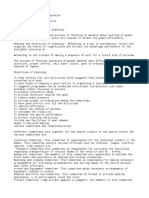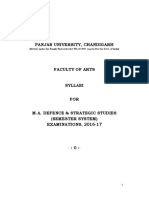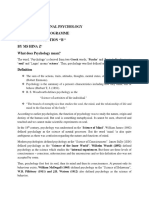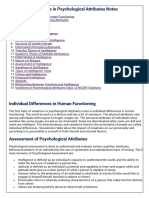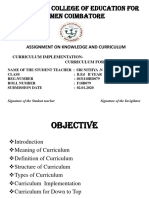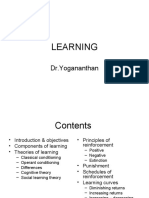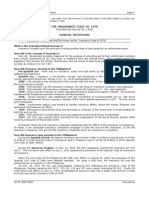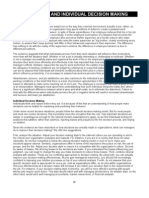Principles of Operant Conditioning
Uploaded by
Lei Ann FernandezPrinciples of Operant Conditioning
Uploaded by
Lei Ann FernandezPrinciples of operant conditioning *Principle of reinforcement= refers to any stimulus that will maintain or increase the strength of a response.
Positive reinforcement= adding something in order to increase a response (praise and reward) Negative reinforcement= taking something away in order to increase response *Principle of shaping= the trainer or experimenter shapes or conditions the natural variations to produce a newly desired actions *Principle of management= adding something aversive in order to decrease a behaviour *Principle of spontaneous recovery= if the reinforcement is withdrawn or terminated responses decreases until it returns to its predetermined frequency ALBERT BANDURAS SOCIAL LEARNING = He believed that people learn from one another via observation, imitation and modelling. = Social learning theory explains human behaviour in terms of continuous reciprocal interactions between cognitive, behavioural and environmental influences MODELLING PROCESS Attention= Refers to attending to what the model is saying or doing before he/she can reproduce a models action Retention= Refers to coding information and keeping it in memory for retrieval in order to reproduce a models action Reproduction= Performing the behaviour he/she observed Reinforcement= Be motivated enough to want to demonstrate what they have learned FACTORS AFFECTING LEARNING 1. Readiness or maturation of the learner 2. Intelligence of the learner 3. Opportunities to learning 4. Environmental condition
5. Health of the learner 6. Attitude of the learner
You might also like
- Perceiving Depth or Distance: Binocular Cues100% (1)Perceiving Depth or Distance: Binocular Cues2 pages
- Adjustment VS Maladjustment: Rubina Alli HansNo ratings yetAdjustment VS Maladjustment: Rubina Alli Hans31 pages
- 20160727161008-m A Defenceandstrategicstudies PDFNo ratings yet20160727161008-m A Defenceandstrategicstudies PDF50 pages
- Notes Ch-1 Variations in psychological attributesNo ratings yetNotes Ch-1 Variations in psychological attributes21 pages
- Top 6 Methods of Educational PsychologyNo ratings yetTop 6 Methods of Educational Psychology13 pages
- DR Radhakrishnan Commission Report On Higher EducationNo ratings yetDR Radhakrishnan Commission Report On Higher Education11 pages
- Research Methods in Psychology - Indian Perspective (P.lodha, A.desousa)No ratings yetResearch Methods in Psychology - Indian Perspective (P.lodha, A.desousa)14 pages
- PAPER-1 Childhood & Growing Up 2022 Eng. MedNo ratings yetPAPER-1 Childhood & Growing Up 2022 Eng. Med59 pages
- Learning and Teaching Important Questions by Being A Best TeacherNo ratings yetLearning and Teaching Important Questions by Being A Best Teacher43 pages
- Creativity: - Concept of Creativity - Types of Creativity - Theory of Creativity - Stages of Creative ThinkingNo ratings yetCreativity: - Concept of Creativity - Types of Creativity - Theory of Creativity - Stages of Creative Thinking6 pages
- 3.1 Age Norms 3.2 Grade Norms 3.3 Percentile Norms 3.4 Standard ScoreNo ratings yet3.1 Age Norms 3.2 Grade Norms 3.3 Percentile Norms 3.4 Standard Score14 pages
- Unit 3 - Attention and Pattern RecognitionNo ratings yetUnit 3 - Attention and Pattern Recognition82 pages
- Value Crisis in Contemporary Indian Society - An Idea in My Plate0% (2)Value Crisis in Contemporary Indian Society - An Idea in My Plate3 pages
- Psychological Foundation (Distance Learning Module)No ratings yetPsychological Foundation (Distance Learning Module)86 pages
- ,SDNFKSJDHF Osdfm, Sdnbcsdfmwsef KSXCMSD F KJSC, Nckjdhfknedfklhcased Jnbckan/Lscmaeihf NC Ajsdc Asd, Ma D/ MNXB Ckjabslda, MCN AdsfNo ratings yet,SDNFKSJDHF Osdfm, Sdnbcsdfmwsef KSXCMSD F KJSC, Nckjdhfknedfklhcased Jnbckan/Lscmaeihf NC Ajsdc Asd, Ma D/ MNXB Ckjabslda, MCN Adsf1 page
- RHYS MURILLO - Insurance Reviewer - Ateneo Law School94% (31)RHYS MURILLO - Insurance Reviewer - Ateneo Law School102 pages
- Legal Forms and Practical Exercises by Prof. Estaniel100% (3)Legal Forms and Practical Exercises by Prof. Estaniel88 pages
- United Nations Human Rights Council - ReportNo ratings yetUnited Nations Human Rights Council - Report7 pages
- The Child and Adolescent Learners and Learning Principles: BraveNo ratings yetThe Child and Adolescent Learners and Learning Principles: Brave6 pages
- Ten Schools of Thoughts of Strategic Management100% (3)Ten Schools of Thoughts of Strategic Management3 pages
- HP Review TranslationasCommunication FinalNo ratings yetHP Review TranslationasCommunication Final6 pages
- The Meanings of The Balinese 'To Eat': A Study of Natural Semantic Metalanguage (NSM)No ratings yetThe Meanings of The Balinese 'To Eat': A Study of Natural Semantic Metalanguage (NSM)15 pages
- Gherardi - Situated Knowledge and Situated Action - What Do Practice-Based Studies PromiseNo ratings yetGherardi - Situated Knowledge and Situated Action - What Do Practice-Based Studies Promise13 pages
- Oliva Schyns - Hybrid Image Illusion Chapter PDFNo ratings yetOliva Schyns - Hybrid Image Illusion Chapter PDF8 pages
- Magic Multiplier & Empathy Magic Multiplier & EmpathyNo ratings yetMagic Multiplier & Empathy Magic Multiplier & Empathy9 pages
- 1 Quarter: - News Reports - Speeches - Informative Talks - Panel Discussions100% (2)1 Quarter: - News Reports - Speeches - Informative Talks - Panel Discussions2 pages
- علم المخاطب بين التوجيه النحوي والتداوليةNo ratings yetعلم المخاطب بين التوجيه النحوي والتداولية26 pages
- Grade: 11 Revision Worksheet/ Answer Key: Education and LearningNo ratings yetGrade: 11 Revision Worksheet/ Answer Key: Education and Learning2 pages
- Communicative Approach Group 8 Tefl AryaNo ratings yetCommunicative Approach Group 8 Tefl Arya6 pages
- Lesson 3: Developmental Stages in Middle and Late Adolescence100% (1)Lesson 3: Developmental Stages in Middle and Late Adolescence12 pages
- Allama Iqbal Open University, Islamabad (Early Childhood Education and Elementary Teacher Education Department) - 1 - 2No ratings yetAllama Iqbal Open University, Islamabad (Early Childhood Education and Elementary Teacher Education Department) - 1 - 23 pages
- Brain Fingerprinting: Geethika Muppa 06771A0528 4-2, CSE February 26, 2010No ratings yetBrain Fingerprinting: Geethika Muppa 06771A0528 4-2, CSE February 26, 201021 pages
- M2 - Silent Period - Learning MaterialsNo ratings yetM2 - Silent Period - Learning Materials19 pages









